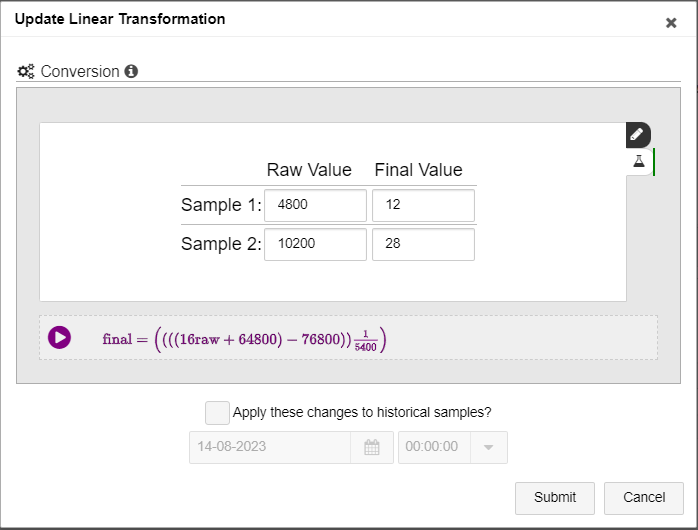This article describes an alternative configuration of the “ratio” conversion method. This alternative ratio conversion is based on actual measurements, rather than on a theoretical value ranges.
Viewing and Editing the Treatment of Raw Data describes two ways to convert raw data to engineering units: formula and ratio. This article describes an alternative configuration of the “ratio” conversion method. This alternative ratio conversion is based on actual measurements, rather than on a theoretical value ranges. As a result, you can get more accurate Final Values, that are specific to a particular sensor.
Overview
Analog measurements are either in the current range of 4-20 mA (represented as 4000-20000) or in the voltage range of 0-5 , 0-10, etc. This range represents the minimum and maximum values that can be measured by the sensor. They are the sensor’s “raw” values – the actual measurement of the sensor. In principle, this measurement value range can be converted directly into appropriate engineering units by a ratio.
For example, if the 4-20 mA sensor is measuring a distance such as water level, rather than describing the distance as inches, millimeters, etc., you can designate the distance as a percentage of the total range. The ratio of the current, 4:20, is the same ratio as the percentage, 0:100. Therefore, if 4 mA is 0 percent of the total range, then 20 mA is 100 percent of the total range. Any current value between 4-20 would be at the corresponding point on the percentage scale:
|
If the Current Value is... |
Then the Percentage Value is... |
|---|---|
| 4 mA | 0 |
| 8 mA | 25 |
| 12 mA | 50 |
| 16 mA | 75 |
| 20 mA | 100 |
This same ratio can be defined for any engineering units, as long as there is a definitive or fixed range for the final values (engineering units). For example, if the analog sensor is a pressure sensor whose range is from 0-50 psi, then the ratio 4:20 is the same as 0:50, where a current measurement of 4 mA=0 psi and 20 mA measurement=50 psi, and all points in between.
These ratios should represent the actual relationship between the sensor’s raw value in current or voltage and the corresponding final value in the representative engineering units. But, this relationship is theoretical.
More Accurate Ratio Definition
If you know any two points (current or voltage with known engineering units), you can change the ratio definition to reflect these known measurements.
For example, if you know that when you measure 4.8 mA the actual pressure is 12 psi, and when you measure 10.2 mA the actual pressure is 28 psi, then you can designate the ratio of the current, 4.8:10.2, is the same as the actual psi measurement, 12:28.
In this case, the ratios are based on actual measurements, rather than just the theoretical range of current and the range of pressure that can be measured by the sensor. You would type in the values in the formula definition  tab :
tab :
